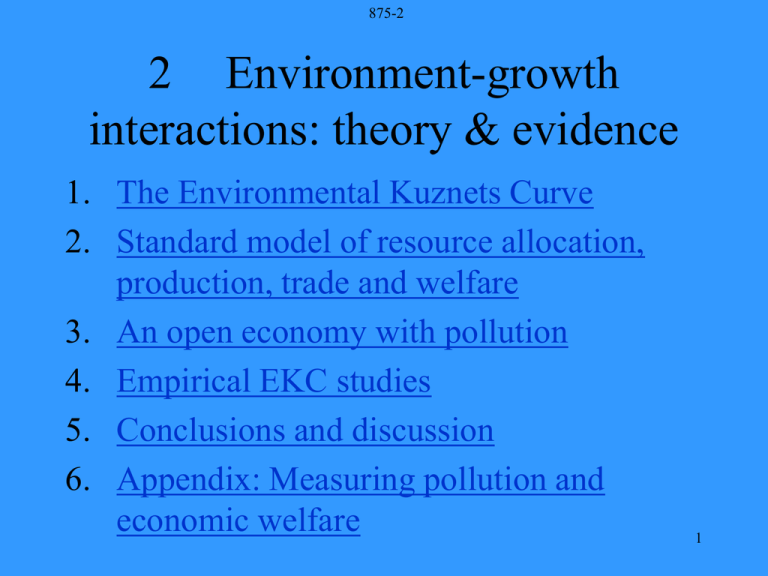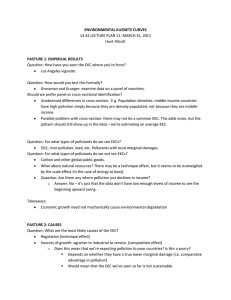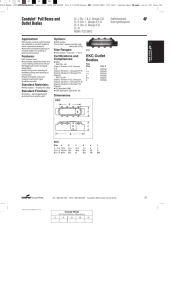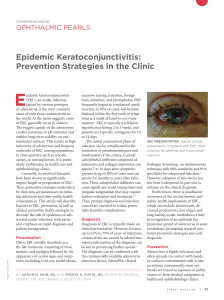Class 2 powerpoint
advertisement

875-2
2 Environment-growth
interactions: theory & evidence
1. The Environmental Kuznets Curve
2. Standard model of resource allocation,
production, trade and welfare
3. An open economy with pollution
4. Empirical EKC studies
5. Conclusions and discussion
6. Appendix: Measuring pollution and
economic welfare
1
875-2
The ‘environmental Kuznets curve’
• With economic
growth, pollution
intensity first
rises, then
declines:
Pollution
per unit o f income (z)
z = z(Y/P)
z’ > 0; z” < 0.
Per capita in come (Y/P)
2
875-2
Components of EKC
• Scale effect (economic expansion)
• Composition effects
– Relative price changes
– ‘Unbalanced growth’-- from several sources
• Technique & preference effects
– Production technology
– Consumer preferences & policy pressures
3
875-2
Factors affecting EKC shape
•
•
•
•
Exogenous market influences (‘globalization’)
Property rights
Externalities
Policy ‘accidents’
(e.g ISI strategies affecting ind’l & ag growth)
* All have economy-wide implications
* Spatial dimensions may also be important
4
875-2
A note on ‘micro’ vs. ‘macro’
approaches
• Agents’ behavior (e.g. firm/farm) is dynamically linked to
macro level changes.
– Economy-wide or global changes affect decision- making by micro
units, through prices, etc.
– Behaviour of micro-units in aggregate affects macro outcomes:
outputs, prices, employment, income distribution, and
environmental externalities
– Indirect and ‘loop back’ effects can be very important
• Micro and macro approaches are complementary. Both are
required.
TOC
5
875-2
1. A standard GE model
• Assume:
– Two goods produced and consumed
– Each good is produced using two factors
• Constant returns to scale
– One factor (labor) is intersectorally mobile; the others
are “specific” to sectors
– Markets are complete and competitive
• Prices are set in world markets
6
875-2
y2
Production
Possibiliti es
b = (y1, y2)
ƒ2(v)
y1
Labor
a = (L1, L2)
Resource
All ocation
ƒ1(v)
Labor
1. Gene ral equili brium of the 2 X 3 econo my
7
875-2
Spot test!
1. Use the diagram to show the value of total
income.
2. For a given set of consumer preferences,
show the pattern of trade.
3. Demonstrate that (a, b) is an equilibrium
(hint: Walras’ Law).
8
875-2
y2
h
b
ƒ2(v)
Inco me (in terms
of y1)
y1
Labor
a
ƒ1(v)
Labor
Gene ral equili brium of the 2 X 3 econo my
9
875-2
y2
b = (y1, y2)
ƒ2(v)
d = (y1', y2'')
y1
L
a = (L1, L2)
c = (L1', L2')
ƒ1(v)
L
2. Produc tion and resource all ocation effects of a price change
10
875-2
Spot test!
•
What happens
to factor returns
when relative
output prices
change?
1. Returns to specific
factors rise (fall) as
sectoral output rises
(falls)
2. Wage change
depends on laborintensity of
expanding sector
11
875-2
y2
b
f
ƒ (v)
2
b
y1
L
a
e
ƒ1(v)
L
3. Effects of an increase in the labor force
12
875-2
Spot test!
1. What happens to
the structure of
output as specific
factor endowments
increase?
2. What is the effect
of technical
progress in a
sector?
TOC
1. The sector using that
factor expands--and
the other contracts
2. That sector’s output
expands, and the
other’s output
contracts
13
875-2
3. An open economy with
pollution
• The Antweiler, Copeland, Taylor (2001) diagram
– ‘Clean’ and ‘dirty’ goods
– Comparative advantage in dirty good
– Tariff on imports of clean good
• Effects of growth or trade:
– scale, composition, technique
14
875-2
Clean
good
UW
UT
A
pT
C
B
pW
YT
YW
Dirt y good
zA
zC
z=2()x
Composition
zB
Scale
zS
Techn ique
z=1()x
Poll ution
Sour ce: Adapted from Antweil er et al. 2001
15
875-2
Growth and pollution
• E.g. factor endowment growth
• Scale and composition effects from growth
– and factor abundance/comp. adv effects
• Technique effects dependent on institutions
(among other things)
16
875-2
Clean
good
C
E
D
pW
Dirt y good
zC
zE
zD
Composition
z=3()x
Scale
zI
Poll ution
Techn ique
z=1()x
17
875-2
Hypothesized motives for
environmental change
• Factor abundance
– Comparative advantage drives NR exploitation
rates in open economies
• ‘Pollution haven’
– Lack of property rights or regulations permits
‘free disposal’ of pollution
• Interactions
– Openness --> pollution when prop. rts. absent.
TOC
18
875-2
4. Empirical EKC studies
Most general model: yit = i + ∑jijxitj
for i in {country}, j in {explanatory
variables} and t in {time}, where
yit is some measure of env/NR,
xitj is an explanatory variable
Some other considerations:
• Set of non-income RHS variables
• Model specification
• Data availability (X-S, panel, quality)
19
875-2
Empirical EKC ‘tests’
• E.g. Panayotou 1993, SO2 emissions:
ln(S/P) = –32.56 + 8.3ln(Y/P) – 0.51[ln(Y/P)]2
• Implication: ‘turning point’ for emissions
intensity -- for the average country in sample.
• Other LHS variables: CO2, water quality,
deforestation, TSP, …
• Other RHS variables: additional terms &
interactions (openness/trade intensity,
institutions, Communist, pop. density, …) 20
875-2
Is there an EKC in Asia?
• Empirical studies:
– Industrial emissions-- maybe.
– Deforestation, water and soil resource
depletion--no robust evidence of EKC (Cropper
and Oates, Stern, Common & Barbier, …)
– Yet experience of wealthy countries suggests
that EKC concept remains a useful working
hypothesis.
TOC
21
875-2
4. Summary and conclusions
•
•
•
•
Assumptions about optimizing behavior
Assumptions about markets and technology
Assumptions about trade
Models must make assumptions explicit and be
demonstrably consistent
• Complications can be introduced, but at a cost
• Target of analysis is important. Is it the
environment only? Or a broader concept of
welfare?
TOC
22
875-2
For next sessions
• Review duality and basic concepts, if
necessary:
– Expenditure, cost and revenue functions
– Trade expenditure function
– “Hat” calculus
• Look at OEE Ch. 2 models, and/or Ulph
(1999).
TOC
23
875-2
Appendix: Environment and
economic welfare
• ACT model tells us what happens to
pollution.
• But consumer utility: u = u(c, -z)
– Price or endowment changes affect c as well as
z: what is the change in net welfare?
– example: trade liberalization
24
875-2
Welf are
R – value of output
C- utilit y from
env ir onmental
qua lit y
Tariff
25
875-2
Spot test!
Q. In the previous example, what is the optimal
tariff, and how is it calculated?
A. Where absolute values of slopes of R and C are
equal (marginal environmental benefit=marginal
cost in terms of consumption)
B. Q. What is the optimal tariff on imports of a
dirty good?
C. A. t = 0.
TOC
26




